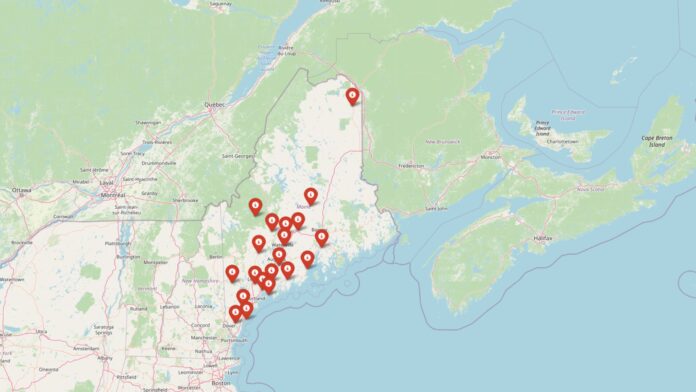Maine’s real estate market still looks strong from the outside, but some towns are showing early warning signs that seasoned analysts know all too well. According to the Zillow Home Value Index, a handful of communities are following patterns that historically lead to price corrections—sudden slowdowns, repeated busts, sharp spikes, and unsustainable growth.
While the state’s median home price is up 2.5% year-over-year to $403,000, these 20 towns aren’t following the same path. Many have surged far beyond long-term pricing trends, setting up the kind of imbalance that rarely lasts. Whether you’re thinking of buying or holding, these are the places where the numbers suggest a potential shakeout may be coming.
20. Newport – Crash Risk Percentage: 65.83%
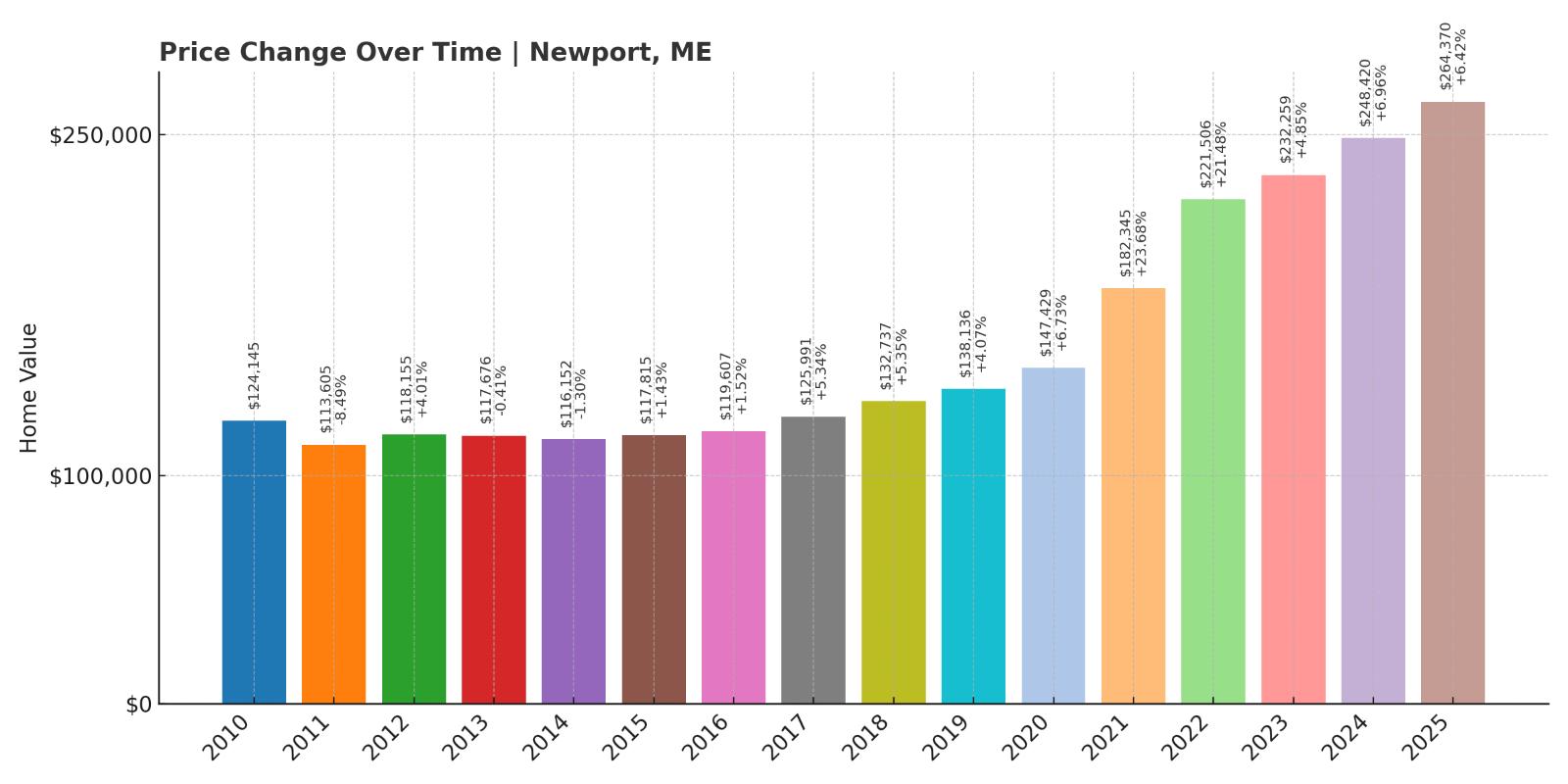
- Crash Risk Percentage: 65.83%
- Historical crashes (8%+ drops): 1
- Worst historical crash: -8.5% (2011)
- Total price increase since 2010: +113.0%
- Overextended above long-term average: +67.8%
- Price volatility (annual swings): 7.8%
- Current 2025 price: $264,370
Newport’s housing market shows clear signs of being dangerously overextended, with prices sitting 67.8% above their long-term average and a staggering 113% increase since 2010. This Penobscot County town of roughly 3,200 residents has seen values more than double in just 15 years, far outpacing the region’s economic fundamentals. The town’s previous 8.5% crash in 2011 demonstrates its vulnerability to market corrections, and current pricing levels suggest another downturn could be even more severe.
Newport – Extreme Overextension Risk

Newport’s housing market exemplifies the dangerous combination of rapid appreciation and mathematical unsustainability that often precedes major corrections. The town’s median home price has more than doubled since 2010, reaching $264,370—a level that far exceeds what local wages can support long-term. With household incomes in the area averaging around $45,000, the affordability gap has widened to dangerous levels that historically signal impending market adjustments.
The town’s infrastructure and amenities, while adequate for a small Maine community, cannot justify the dramatic price increases seen over the past decade. Newport’s location approximately 20 miles west of Bangor provides some economic stability through proximity to the region’s largest city, but this connection hasn’t translated into the kind of job growth or wage increases needed to sustain current housing valuations. As mortgage rates remain elevated and buyer demand softens, Newport’s overheated market appears primed for a significant correction.
19. New Gloucester – Crash Risk Percentage: 66.88%
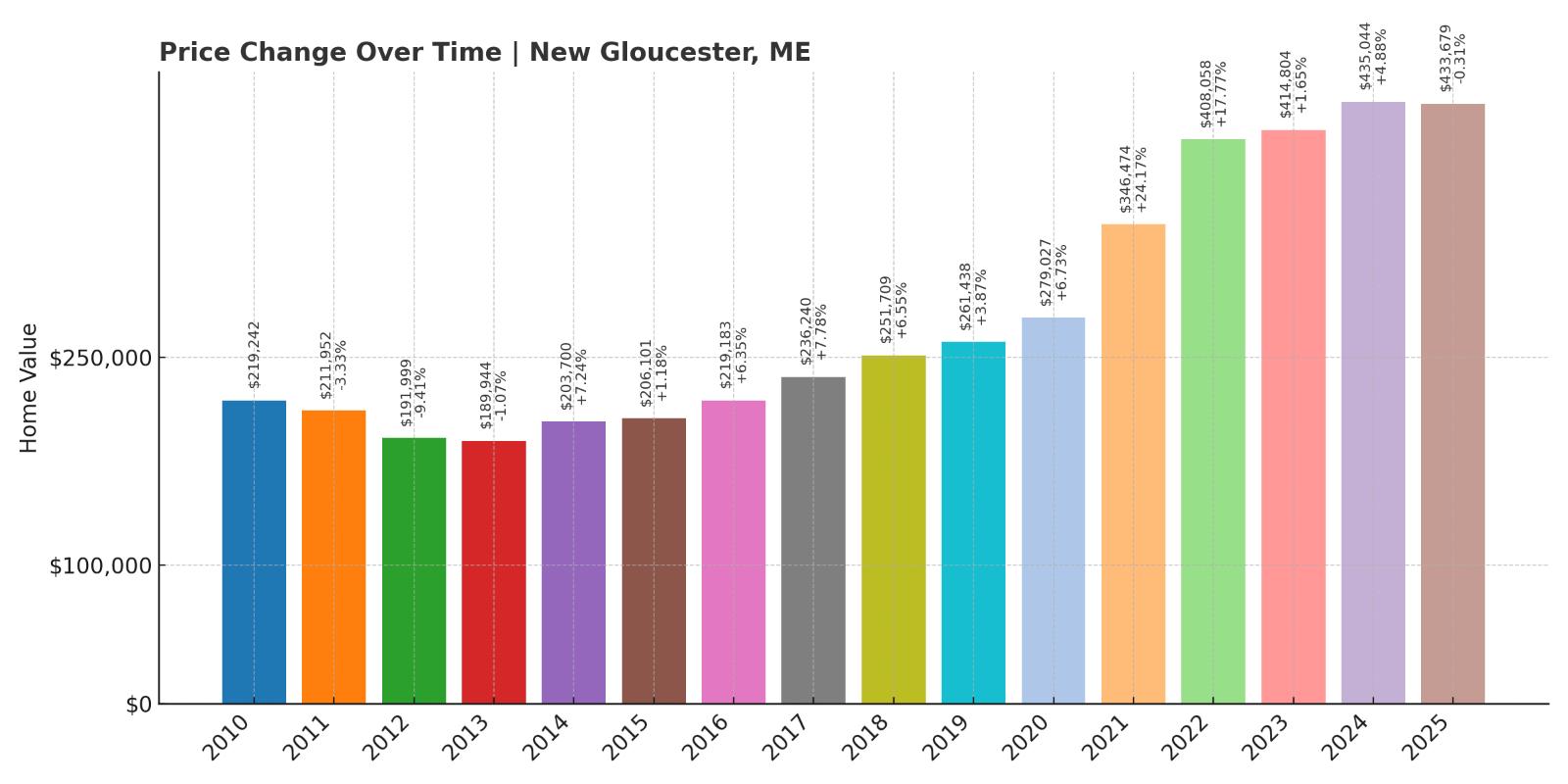
- Crash Risk Percentage: 66.88%
- Historical crashes (8%+ drops): 1
- Worst historical crash: -9.4% (2012)
- Total price increase since 2010: +97.8%
- Overextended above long-term average: +53.9%
- Price volatility (annual swings): 7.8%
- Current 2025 price: $433,679
New Gloucester presents a concerning profile with its current median price of $433,679 representing a 97.8% increase since 2010 and sitting 53.9% above long-term averages. This Cumberland County community experienced a notable 9.4% crash in 2012, demonstrating its susceptibility to market downturns. The town’s proximity to Portland has driven some of the appreciation, but current valuations appear disconnected from local economic realities.
New Gloucester – Portland Area Bubble Territory

New Gloucester’s housing market reflects the broader overextension plaguing Greater Portland’s suburban communities, where proximity to Maine’s economic center has driven prices beyond sustainable levels. The town’s current median home price of $433,679 represents nearly a doubling of values since 2010, yet local employment opportunities and wage growth haven’t kept pace with this dramatic appreciation. Most residents commute to Portland or Lewiston for work, making the housing market particularly vulnerable to changes in employment patterns or transportation costs.
The community’s rural character and good school system have attracted families fleeing higher-cost areas, but this demand-driven appreciation has created its own problems. New Gloucester now faces the challenge of maintaining affordability for local workers while dealing with inflated property valuations that appear increasingly disconnected from the area’s economic fundamentals. With inventory levels rising across Maine and buyer demand softening, towns like New Gloucester that experienced rapid pandemic-era appreciation face the highest risk of meaningful price corrections.
18. Orland – Crash Risk Percentage: 68.21%

- Crash Risk Percentage: 68.21%
- Historical crashes (8%+ drops): 1
- Worst historical crash: -10.0% (2011)
- Total price increase since 2010: +120.8%
- Overextended above long-term average: +65.4%
- Price volatility (annual swings): 7.5%
- Current 2025 price: $298,120
Orland stands out with the highest total price appreciation in our analysis at 120.8% since 2010, pushing its median home value to $298,120—a level that’s 65.4% above long-term trends. This Hancock County town previously crashed 10% in 2011, and current conditions suggest an even more severe correction could be approaching. The combination of extreme appreciation and significant overextension creates a particularly unstable foundation for sustained home values.
Orland – Coastal Premium Gone Too Far

Orland’s 120.8% price increase since 2010 represents one of the most extreme examples of housing market overextension in Maine, with current values reaching $298,120 for a median home. This Hancock County community has been caught up in the broader coastal Maine real estate frenzy, but its small size and limited economic base cannot support such dramatic appreciation. The town’s previous 10% crash in 2011 occurred during a much milder market correction, suggesting that current overvaluation could lead to an even more severe downturn.
The community’s appeal lies in its rural character and proximity to Acadia National Park, attracting both seasonal residents and remote workers. However, this demand has pushed prices far beyond what local wages can support, creating a market increasingly dependent on outside buyers. As mortgage rates remain elevated and discretionary spending tightens, communities like Orland that rely heavily on lifestyle buyers face particular vulnerability to rapid price declines when market sentiment shifts.
17. Canaan – Crash Risk Percentage: 70.11%
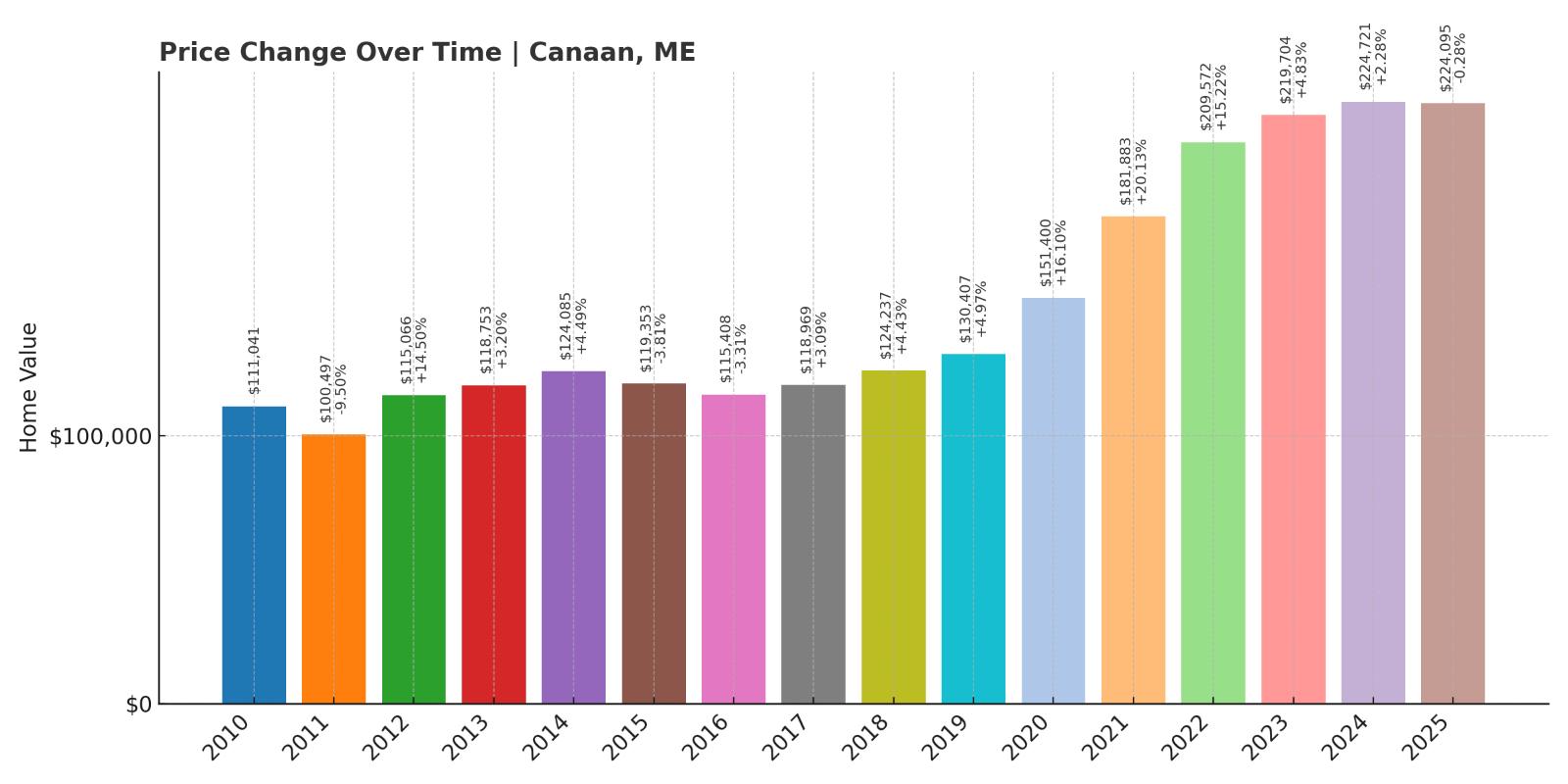
- Crash Risk Percentage: 70.11%
- Historical crashes (8%+ drops): 1
- Worst historical crash: -9.5% (2011)
- Total price increase since 2010: +101.8%
- Overextended above long-term average: +50.1%
- Price volatility (annual swings): 7.9%
- Current 2025 price: $224,095
Canaan’s housing market exhibits classic warning signs of impending correction, with its median price of $224,095 representing a 101.8% increase since 2010 and currently sitting 50.1% above historical norms. This Somerset County town experienced a 9.5% crash in 2011, demonstrating its vulnerability to market downturns. The combination of doubled home values and significant overextension creates an unstable foundation that appears unsustainable given local economic conditions.
Canaan – Rural Overvaluation Warning

Canaan represents a troubling example of how Maine’s housing bubble has spread beyond coastal and urban areas into rural communities with limited economic fundamentals. The town’s current median home price of $224,095 may seem reasonable compared to other Maine markets, but it represents a more than doubling of values since 2010 in an area where median household incomes remain well below $50,000. This dramatic appreciation has occurred without corresponding improvements in local employment opportunities or wage growth.
The community’s rural character and outdoor recreation opportunities have attracted buyers from more expensive markets, but this demand-driven pricing has created unsustainable conditions. Canaan’s economy relies primarily on small-scale agriculture, forestry, and local services—industries that cannot support the current level of home values. As market conditions tighten and speculative demand diminishes, rural communities like Canaan face particular risk of sharp corrections due to their thin buyer pools and limited economic diversity.
16. Caribou – Crash Risk Percentage: 70.23%
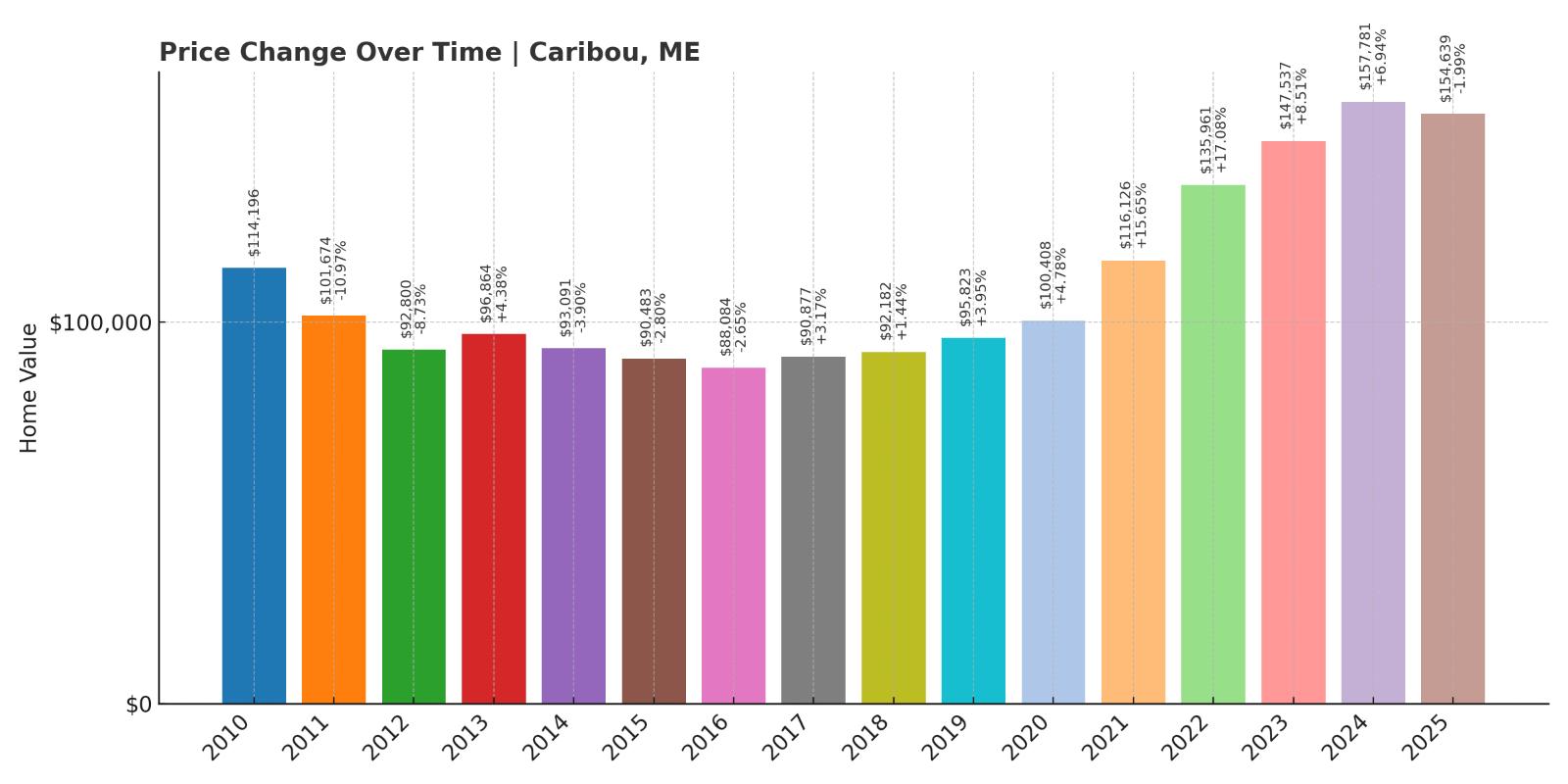
- Crash Risk Percentage: 70.23%
- Historical crashes (8%+ drops): 2
- Worst historical crash: -11.0% (2011)
- Total price increase since 2010: +35.4%
- Overextended above long-term average: +39.9%
- Price volatility (annual swings): 7.6%
- Current 2025 price: $154,639
Caribou presents a unique risk profile as one of only two towns in our analysis with multiple historical crashes, having experienced two significant downturns with the worst reaching 11% in 2011. Despite more modest total appreciation of 35.4% since 2010, the town’s current median price of $154,639 still sits 39.9% above long-term averages. This Aroostook County community’s pattern of repeated crashes suggests particular vulnerability to future corrections.
Caribou – Repeat Crash Offender
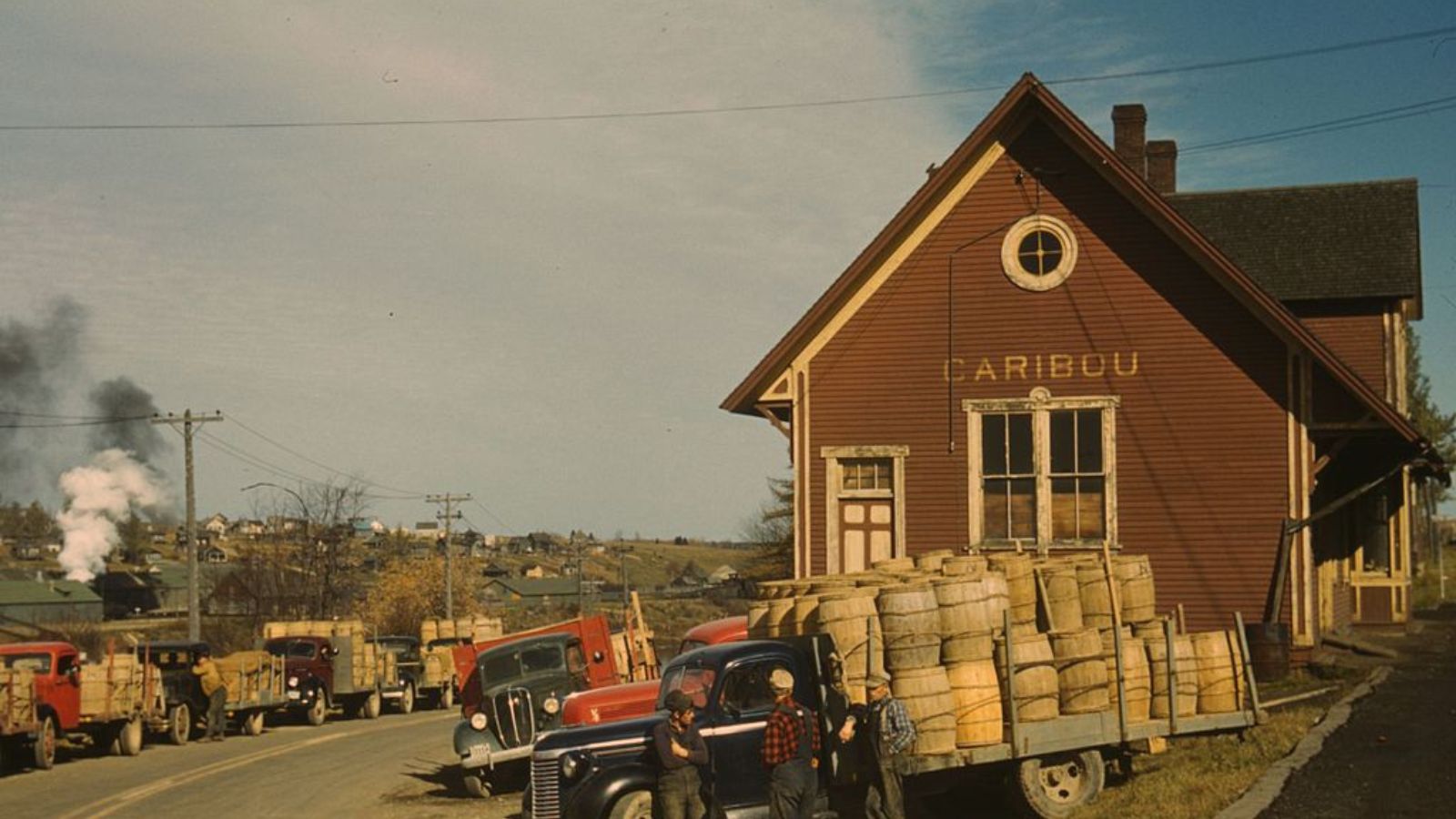
Caribou’s distinction as one of only two communities in our analysis with multiple historical housing crashes makes it particularly concerning for current homeowners. The town’s worst crash of 11% in 2011 was severe, but its pattern of repeated downturns suggests fundamental instability in the local housing market. Despite the current median price of $154,639 appearing affordable by Maine standards, it represents a 39.9% overextension above the town’s long-term pricing trends.
The community faces significant economic headwinds including population decline, limited job growth, and its remote location in Aroostook County far from Maine’s economic centers. Caribou’s economy relies heavily on agriculture, particularly potato farming, and government employment, neither of which has shown the growth necessary to support sustained housing appreciation. The combination of proven crash vulnerability, current overvaluation, and weak economic fundamentals positions Caribou for potential severe value declines as market conditions deteriorate across Maine.
15. Bowdoinham – Crash Risk Percentage: 71.95%
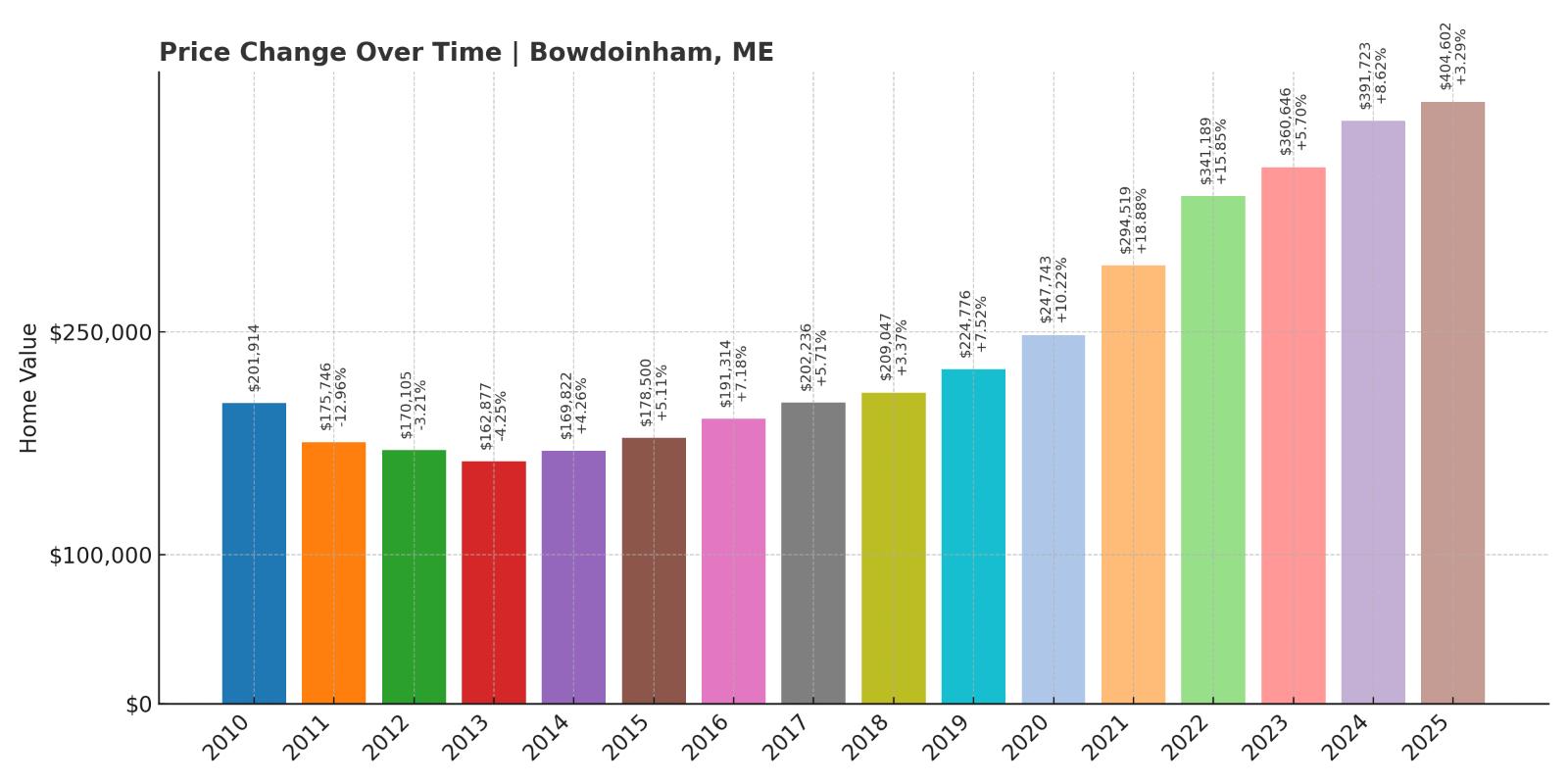
- Crash Risk Percentage: 71.95%
- Historical crashes (8%+ drops): 1
- Worst historical crash: -13.0% (2011)
- Total price increase since 2010: +100.4%
- Overextended above long-term average: +64.9%
- Price volatility (annual swings): 7.5%
- Current 2025 price: $404,602
Bowdoinham’s housing market shows alarming signs of instability, with a current median price of $404,602 representing a 100.4% increase since 2010 and sitting 64.9% above long-term trends. The town experienced a severe 13% crash in 2011, one of the worst in our analysis, demonstrating its capacity for dramatic value declines. This Sagadahoc County community’s combination of doubled home values and significant overextension creates particularly dangerous conditions for homeowners.
Bowdoinham – Severe Crash History

Bowdoinham’s 13% crash in 2011 ranks among the most severe housing corrections in Maine during that period, demonstrating the community’s vulnerability to dramatic value swings. The current median home price of $404,602 represents exactly double the 2010 levels, creating an unsustainable situation given local economic conditions. This Sagadahoc County town’s location between larger communities has driven appreciation, but current valuations appear disconnected from fundamental support factors.
The community’s appeal stems from its small-town character, historic charm, and reasonable access to employment centers, but these advantages cannot justify the extreme price appreciation witnessed over the past 15 years. Bowdoinham’s economy relies primarily on residents commuting to other areas for employment, making the housing market particularly sensitive to changes in transportation costs, employment patterns, and regional economic conditions. The combination of proven crash vulnerability and current extreme overvaluation positions the town for potentially severe corrections as market dynamics shift.
14. Livermore Falls – Crash Risk Percentage: 74.39%
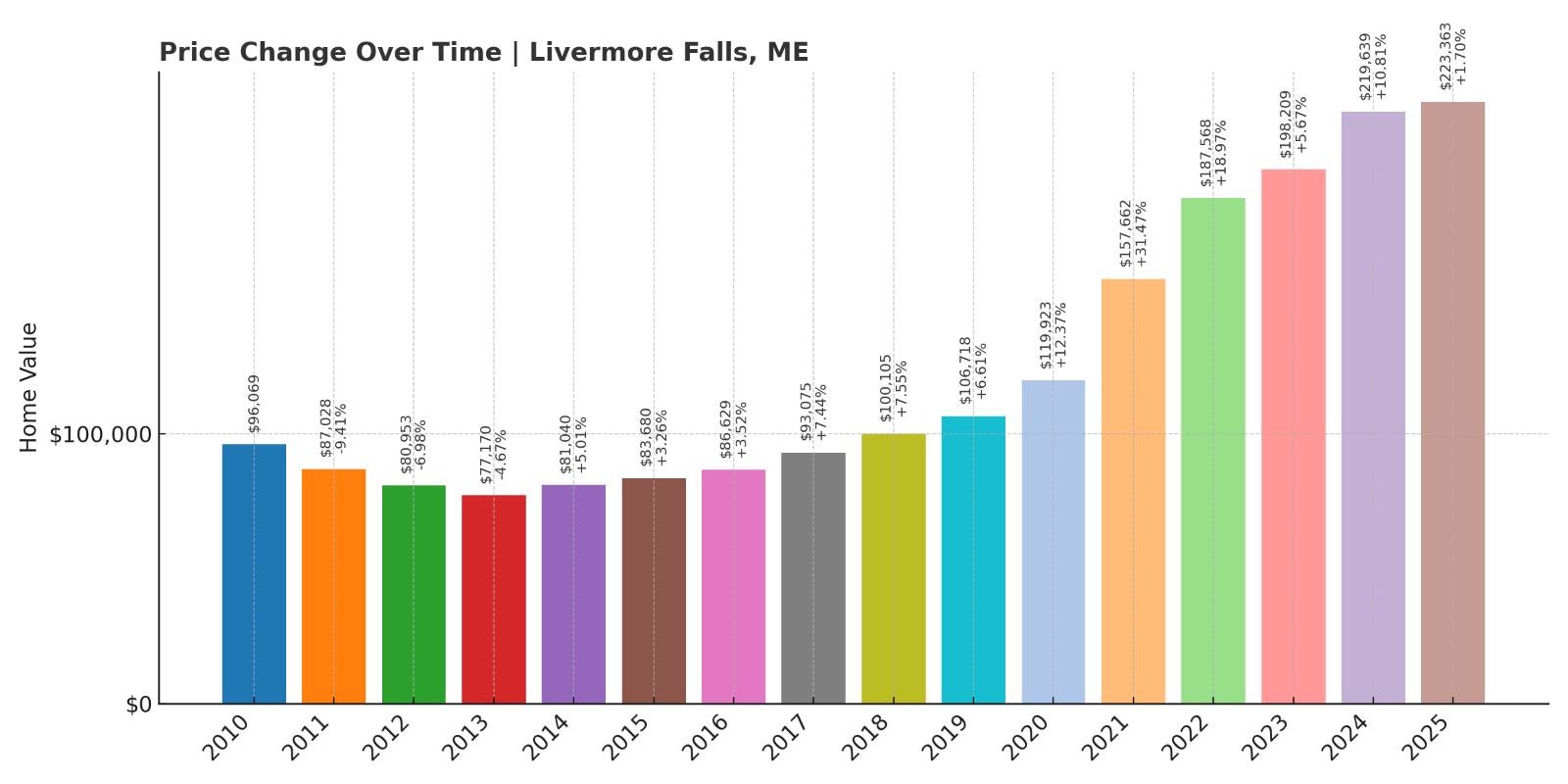
- Crash Risk Percentage: 74.39%
- Historical crashes (8%+ drops): 1
- Worst historical crash: -9.4% (2011)
- Total price increase since 2010: +132.5%
- Overextended above long-term average: +78.8%
- Price volatility (annual swings): 9.8%
- Current 2025 price: $223,363
Livermore Falls presents one of the most concerning overextension scenarios in our analysis, with current home values sitting 78.8% above long-term averages and showing high volatility of 9.8% annually. The town’s median price of $223,363 represents a massive 132.5% increase since 2010, far exceeding sustainable appreciation levels. This Androscoggin County community’s previous 9.4% crash in 2011 occurred when overvaluation was much less severe than current conditions.
Livermore Falls – Extreme Overextension Alert

Livermore Falls exhibits the most dangerous form of housing market overextension in our analysis, with current values sitting nearly 79% above long-term trends—a level that historically signals impending severe corrections. The town’s median home price of $223,363 represents a 132.5% increase since 2010, creating mathematical unsustainability that cannot be maintained given local economic conditions. This level of overvaluation far exceeds what existed before the town’s 2011 crash, suggesting a potentially more severe correction ahead.
The community’s transformation from a traditional mill town to a commuter location has driven much of the appreciation, but current pricing levels have eliminated affordability for local workers. Livermore Falls’ high price volatility of 9.8% annually indicates an unstable market prone to rapid swings, while the extreme overextension creates conditions ripe for a significant correction. As mortgage rates remain elevated and buyer demand softens, this Androscoggin County community faces particular risk of sharp value declines that could exceed historical crash patterns.
13. Fairfield – Crash Risk Percentage: 75.44%

- Crash Risk Percentage: 75.44%
- Historical crashes (8%+ drops): 1
- Worst historical crash: -8.8% (2011)
- Total price increase since 2010: +106.8%
- Overextended above long-term average: +64.5%
- Price volatility (annual swings): 8.4%
- Current 2025 price: $237,295
Fairfield’s housing market shows clear signs of dangerous overextension, with its current median price of $237,295 representing a 106.8% increase since 2010 and sitting 64.5% above historical averages. This Somerset County town experienced an 8.8% crash in 2011, and current overvaluation levels suggest potential for a more severe correction. The combination of doubled home values and significant overextension creates unstable market conditions that appear unsustainable.
Fairfield – College Town Bubble

Fairfield’s proximity to Waterville and Colby College has contributed to housing demand, but current pricing levels have pushed far beyond what the local economy can sustain long-term. The town’s median home price of $237,295 represents more than a doubling since 2010, creating affordability challenges for residents who work in local businesses, education, or municipal services. This Somerset County community’s previous 8.8% crash in 2011 demonstrates its vulnerability to corrections, and current overvaluation suggests potential for more severe declines.
The community’s location along the Kennebec River provides scenic appeal and recreational opportunities, but these lifestyle factors cannot justify the extreme price appreciation witnessed over the past decade. Fairfield’s economy relies heavily on its connection to nearby Waterville and regional employers, making the housing market particularly sensitive to changes in the broader central Maine economy. The combination of proven crash history, significant overextension, and moderate volatility creates conditions ripe for meaningful value corrections as market dynamics shift.
12. North Berwick – Crash Risk Percentage: 76.69%
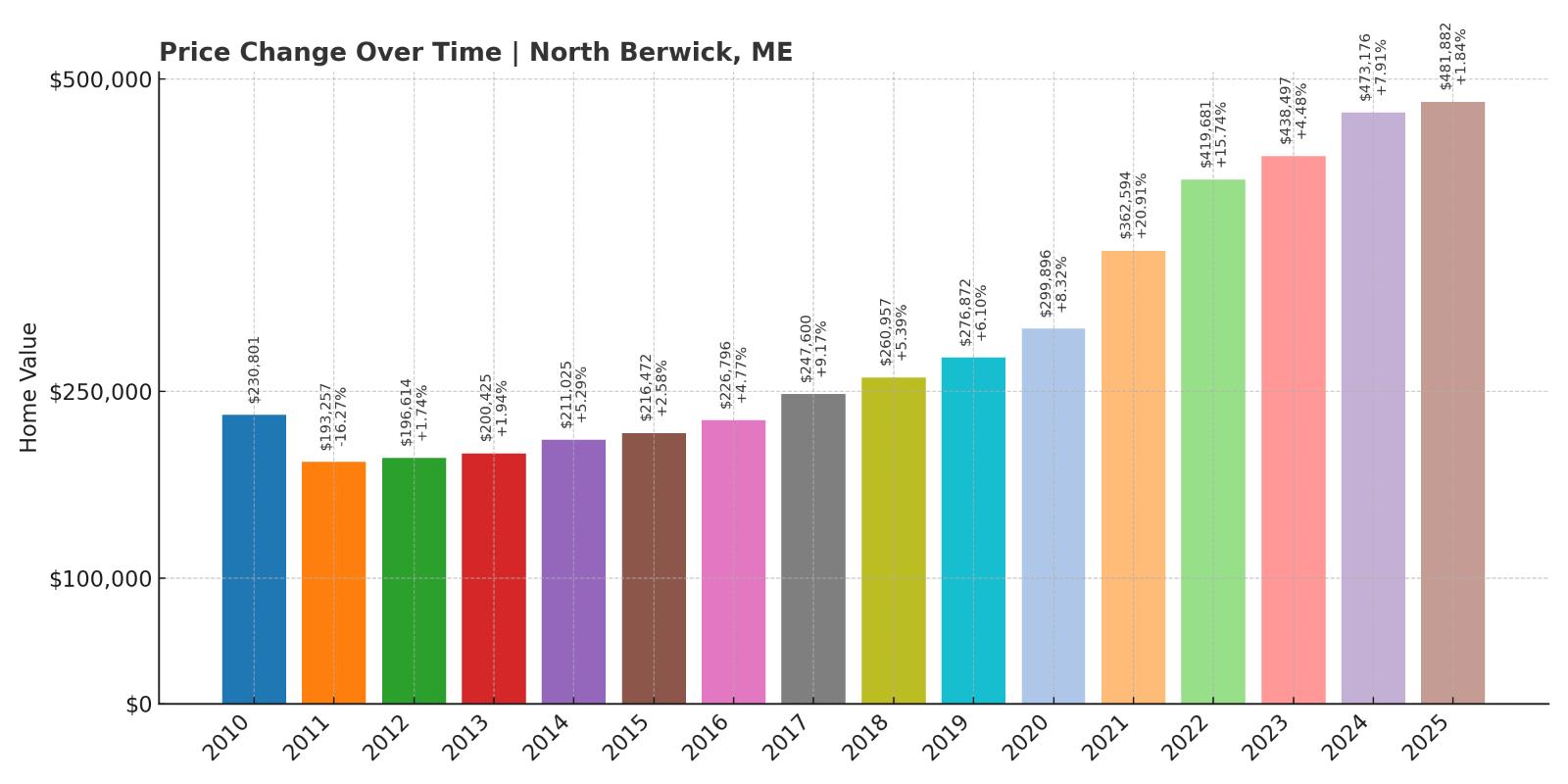
- Crash Risk Percentage: 76.69%
- Historical crashes (8%+ drops): 1
- Worst historical crash: -16.3% (2011)
- Total price increase since 2010: +108.8%
- Overextended above long-term average: +62.8%
- Price volatility (annual swings): 7.7%
- Current 2025 price: $481,882
North Berwick experienced one of the most severe crashes in our analysis with a devastating 16.3% decline in 2011, yet current conditions suggest even greater vulnerability today. The town’s median home price has reached $481,882, representing a 108.8% increase since 2010 and sitting 62.8% above long-term trends. This York County community’s combination of extreme historical crash severity and current overextension creates particularly dangerous conditions for homeowners.
North Berwick – Severe Crash Precedent

North Berwick’s 16.3% crash in 2011 stands as one of the most severe housing corrections in Maine during that period, demonstrating the community’s capacity for dramatic value swings. The current median home price of $481,882 represents more than double the 2010 levels, creating an even more precarious situation than existed before the previous crash. This York County town’s location near the New Hampshire border has attracted buyers from higher-cost markets, but current valuations appear unsustainable given local economic conditions.
The community’s appeal lies in its small-town character combined with reasonable access to employment centers in both Maine and New Hampshire, but these advantages cannot support the extreme price appreciation witnessed over the past 15 years. North Berwick’s economy provides limited local employment opportunities, making residents heavily dependent on commuting to other areas for work. The combination of proven severe crash vulnerability and current extreme overvaluation positions the town for potentially devastating value declines that could exceed even the harsh 2011 correction.
11. Dayton – Crash Risk Percentage: 79.77%
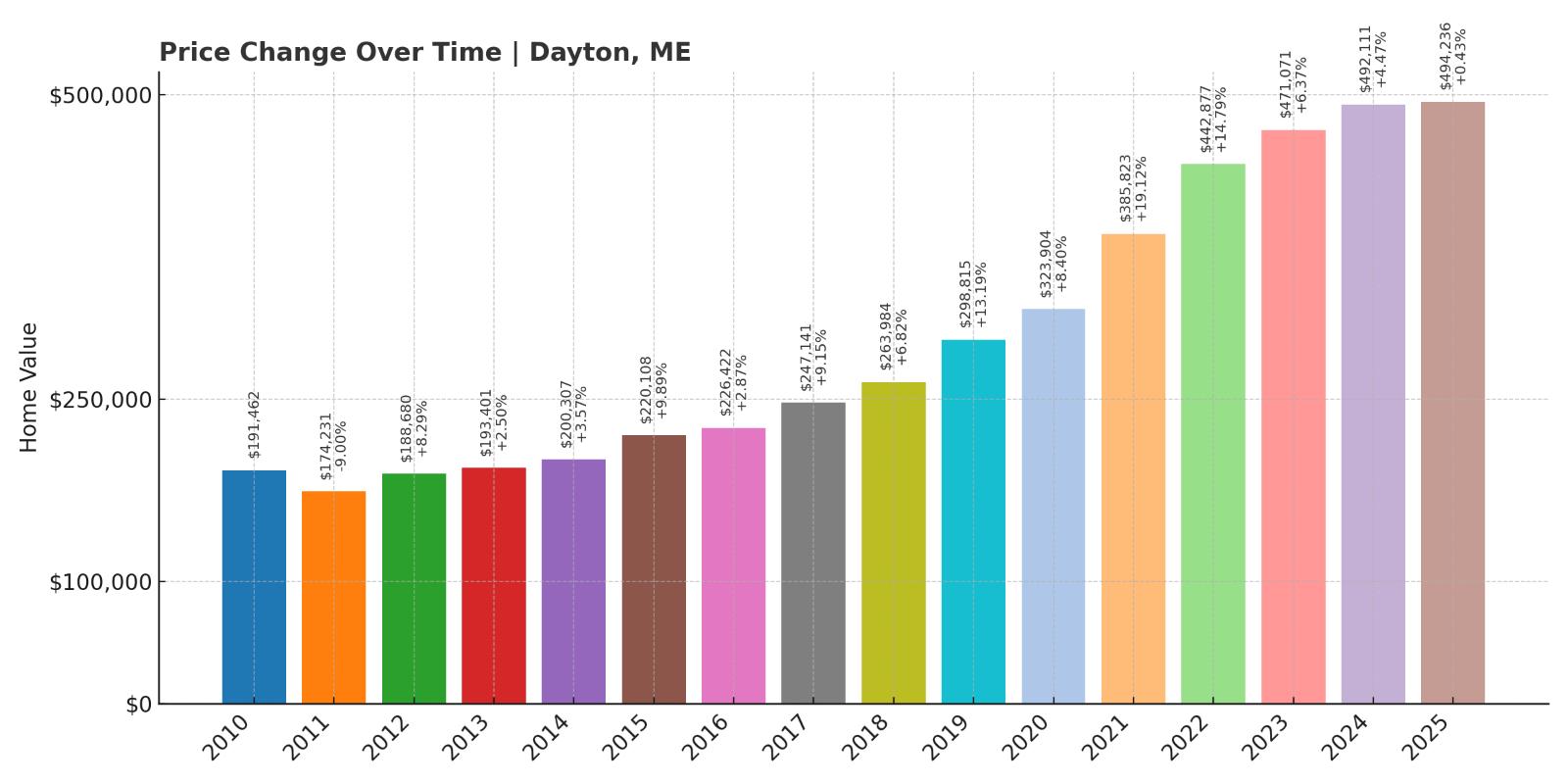
- Crash Risk Percentage: 79.77%
- Historical crashes (8%+ drops): 1
- Worst historical crash: -9.0% (2011)
- Total price increase since 2010: +158.1%
- Overextended above long-term average: +64.2%
- Price volatility (annual swings): 6.4%
- Current 2025 price: $494,236
Dayton shows the highest total price appreciation in our top 11 at 158.1% since 2010, pushing the median home value to $494,236—a level that’s 64.2% above long-term averages. This York County community experienced a 9% crash in 2011, but current overvaluation far exceeds what existed before that correction. The massive price increases have created mathematical unsustainability that appears increasingly disconnected from local economic realities.
Dayton – Extreme Appreciation Warning

Dayton’s 158.1% price appreciation since 2010 represents one of the most extreme examples of housing market inflation in Maine, with the current median home price of $494,236 creating affordability challenges that extend far beyond local economic capacity. This York County community has been caught up in the broader southern Maine real estate frenzy, but its small size and limited economic base cannot sustain such dramatic valuation increases. The town’s previous 9% crash in 2011 occurred when overvaluation was much less severe than current conditions.
The community’s location between Biddeford and the New Hampshire border has attracted buyers seeking more affordable alternatives to coastal properties, but this demand has pushed prices far beyond sustainable levels. Dayton’s economy provides minimal local employment opportunities, with most residents commuting to other areas for work, making the housing market particularly vulnerable to changes in regional economic conditions. The extreme appreciation combined with current overextension creates conditions ripe for a severe correction that could significantly exceed the town’s previous crash experience.
10. Kennebunkport – Crash Risk Percentage: 80.28%
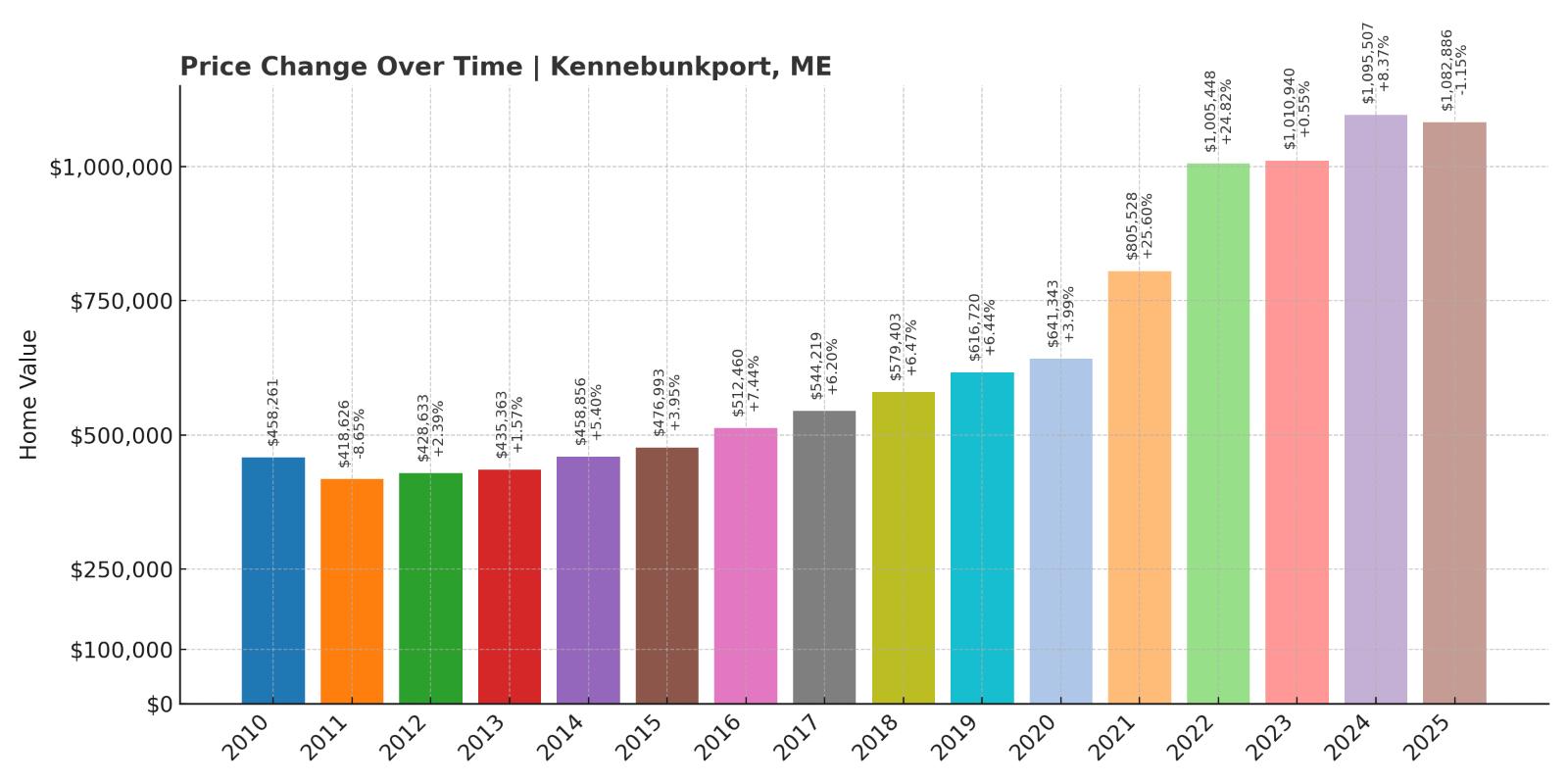
- Crash Risk Percentage: 80.28%
- Historical crashes (8%+ drops): 1
- Worst historical crash: -8.6% (2011)
- Total price increase since 2010: +136.3%
- Overextended above long-term average: +63.9%
- Price volatility (annual swings): 8.5%
- Current 2025 price: $1,082,886
Kennebunkport’s median home price has reached $1,082,886, representing a 136.3% increase since 2010 and sitting 63.9% above long-term trends. This York County coastal community experienced an 8.6% crash in 2011, but current overvaluation levels create potential for much more severe corrections. The town’s high price volatility of 8.5% indicates an unstable market prone to rapid swings, particularly concerning given the extreme valuation levels.
Kennebunkport – Luxury Market Vulnerability

Kennebunkport’s median home price of $1,082,886 places it in luxury territory that makes the community particularly vulnerable to discretionary spending changes and economic uncertainty. The town’s 136.3% appreciation since 2010 has pushed values far beyond what even affluent buyers can easily justify, creating a market increasingly dependent on speculative demand and lifestyle purchases. This York County coastal community’s high price volatility of 8.5% signals an unstable foundation beneath the premium valuations.
The community’s fame and coastal location have long attracted wealthy buyers, but current pricing levels appear to have reached mathematical unsustainability even for high-end markets. Kennebunkport’s economy relies heavily on tourism, seasonal residents, and discretionary spending—all areas particularly vulnerable to economic downturns and changing consumer confidence. The combination of extreme overvaluation, high volatility, and dependence on discretionary buyers creates conditions where even modest market shifts could trigger significant value declines in this prestigious coastal enclave.
9. Denmark – Crash Risk Percentage: 82.42%
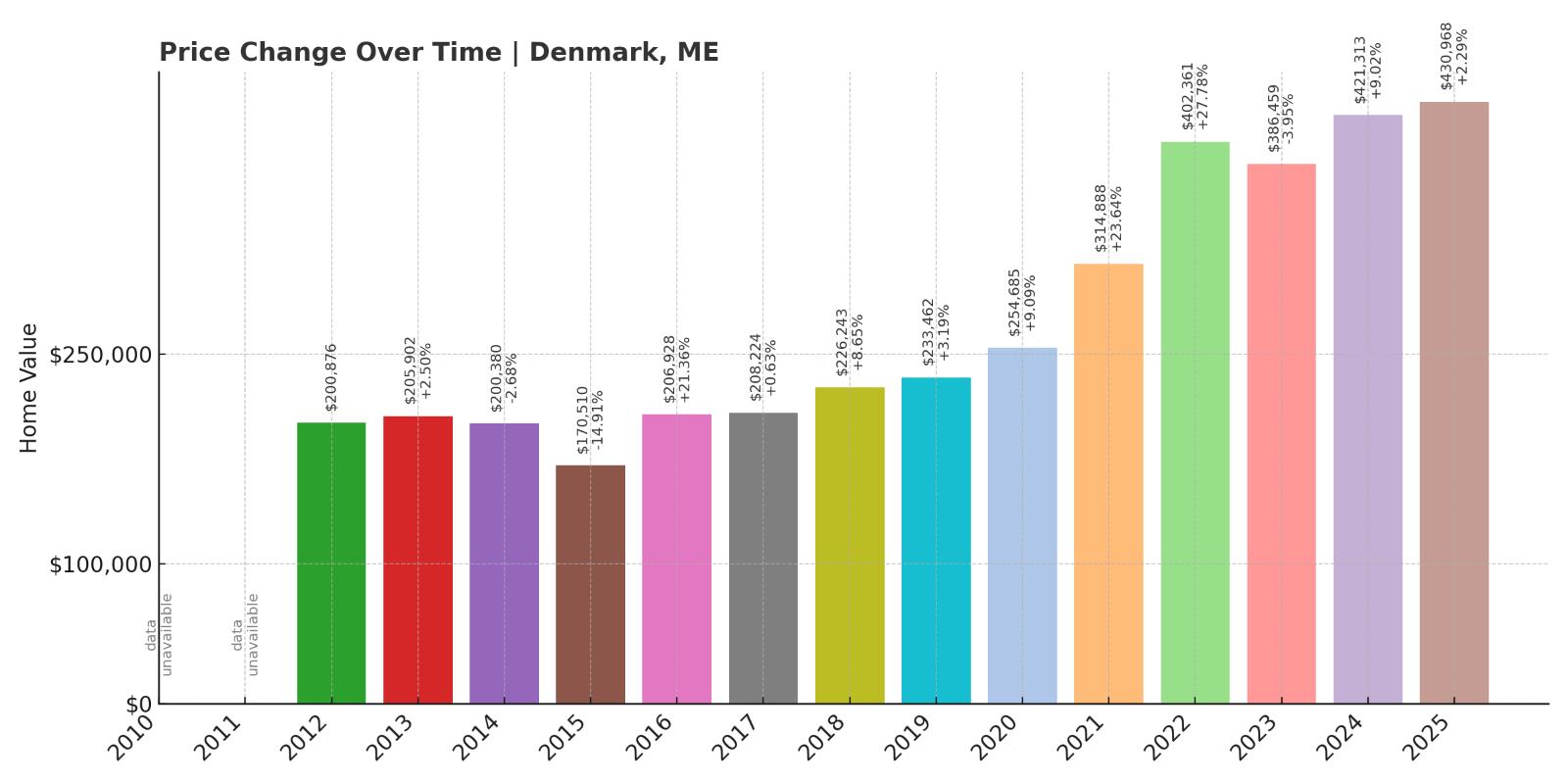
- Crash Risk Percentage: 82.42%
- Historical crashes (8%+ drops): 1
- Worst historical crash: -14.9% (2015)
- Total price increase since 2010: +114.5%
- Overextended above long-term average: +56.2%
- Price volatility (annual swings): 11.5%
- Current 2025 price: $430,968
Denmark stands out with the highest price volatility in our analysis at 11.5% annually and a severe 14.9% crash in 2015—more recent than most communities studied. The town’s current median price of $430,968 represents a 114.5% increase since 2010 and sits 56.2% above historical norms. This Oxford County community’s combination of extreme volatility and recent crash history creates particularly unstable conditions for sustained home values.
Denmark – Extreme Volatility Risk
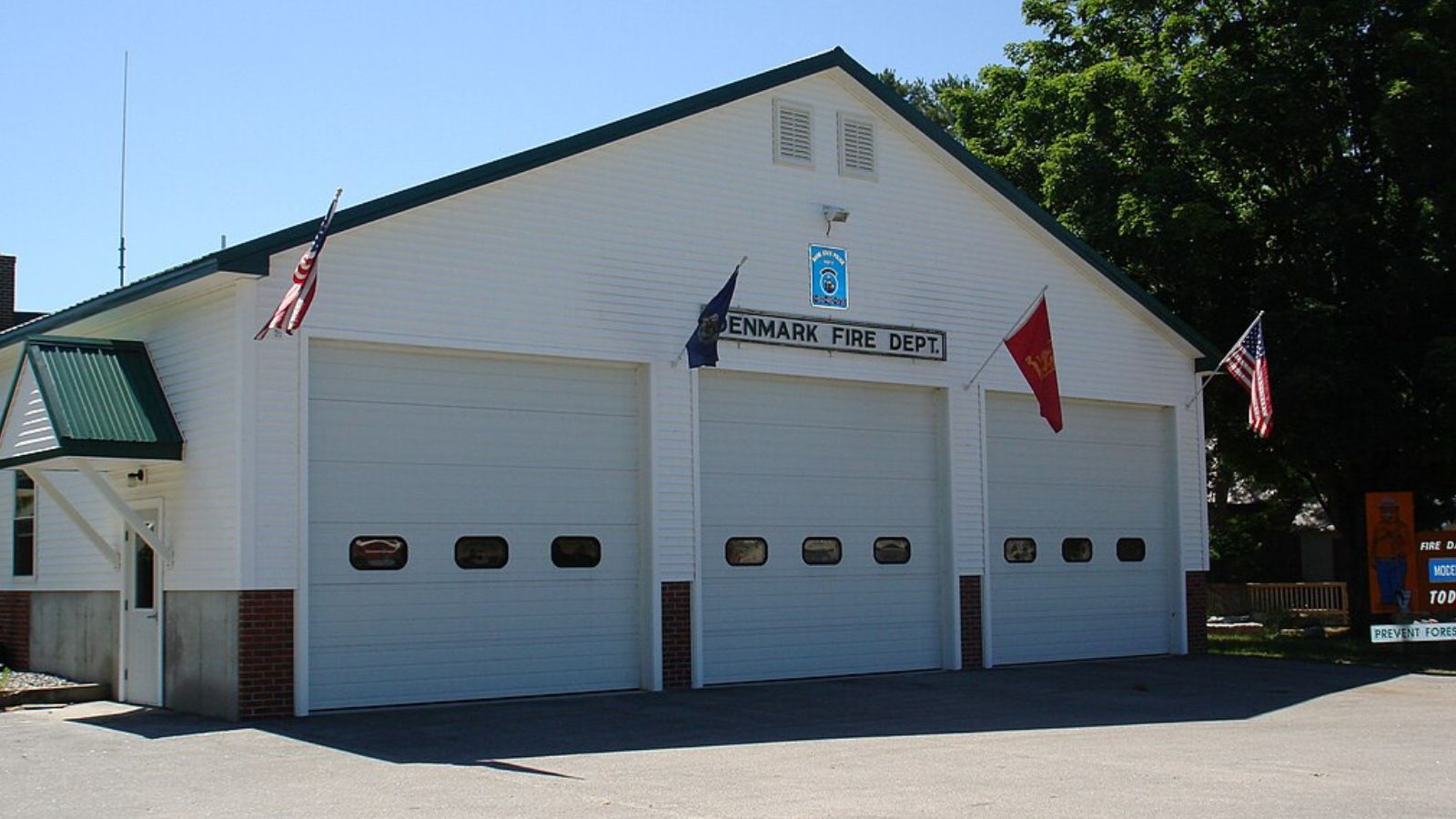
Denmark’s 11.5% annual price volatility represents the most unstable housing market in our analysis, creating conditions where rapid and severe value swings become increasingly likely. The town’s 14.9% crash in 2015 was both recent and severe, occurring during a period of relative market stability elsewhere, suggesting fundamental weaknesses in the local housing market. The current median home price of $430,968 sits 56.2% above long-term trends, creating mathematical unsustainability in a market already proven to be highly unstable.
The community’s appeal lies in its lakes region location and proximity to New Hampshire’s White Mountains, attracting seasonal residents and outdoor recreation enthusiasts. However, Denmark’s economy provides minimal local employment opportunities, making the housing market entirely dependent on outside buyers and discretionary spending. The combination of extreme volatility, recent severe crash history, and significant overextension creates a perfect storm for potentially devastating value corrections as market conditions deteriorate across Maine.
8. Carrabassett Valley – Crash Risk Percentage: 82.78%

- Crash Risk Percentage: 82.78%
- Historical crashes (8%+ drops): 1
- Worst historical crash: -9.8% (2012)
- Total price increase since 2010: +112.8%
- Overextended above long-term average: +63.1%
- Price volatility (annual swings): 9.4%
- Current 2025 price: $601,454
Carrabassett Valley’s housing market shows concerning instability with its current median price of $601,454 representing a 112.8% increase since 2010 and sitting 63.1% above long-term averages. This Franklin County resort community experienced a 9.8% crash in 2012, and current overvaluation levels suggest potential for more severe corrections. The town’s high price volatility of 9.4% indicates an unstable market particularly vulnerable to rapid swings.
Carrabassett Valley – Resort Market Bubble

Carrabassett Valley’s status as a premier ski resort destination has driven dramatic price appreciation, but current valuations appear disconnected from sustainable market fundamentals even for recreational properties. The town’s median home price of $601,454 represents more than double the 2010 levels, creating affordability challenges that extend beyond typical vacation home buyers. This Franklin County community’s dependence on Sugarloaf Mountain and winter recreation makes it particularly vulnerable to changes in tourism patterns, climate concerns, and discretionary spending shifts.
The community’s small year-round population and limited economic diversity outside of resort activities create inherent market instability that becomes amplified during broader economic uncertainty. Carrabassett Valley’s 9.8% crash in 2012 occurred during a relatively mild national correction, suggesting the local market’s vulnerability to external pressures. The combination of extreme overvaluation, resort market dependence, and proven crash history creates conditions where even modest shifts in buyer sentiment could trigger significant value corrections in this mountain resort community.
7. Milo – Crash Risk Percentage: 83.55%
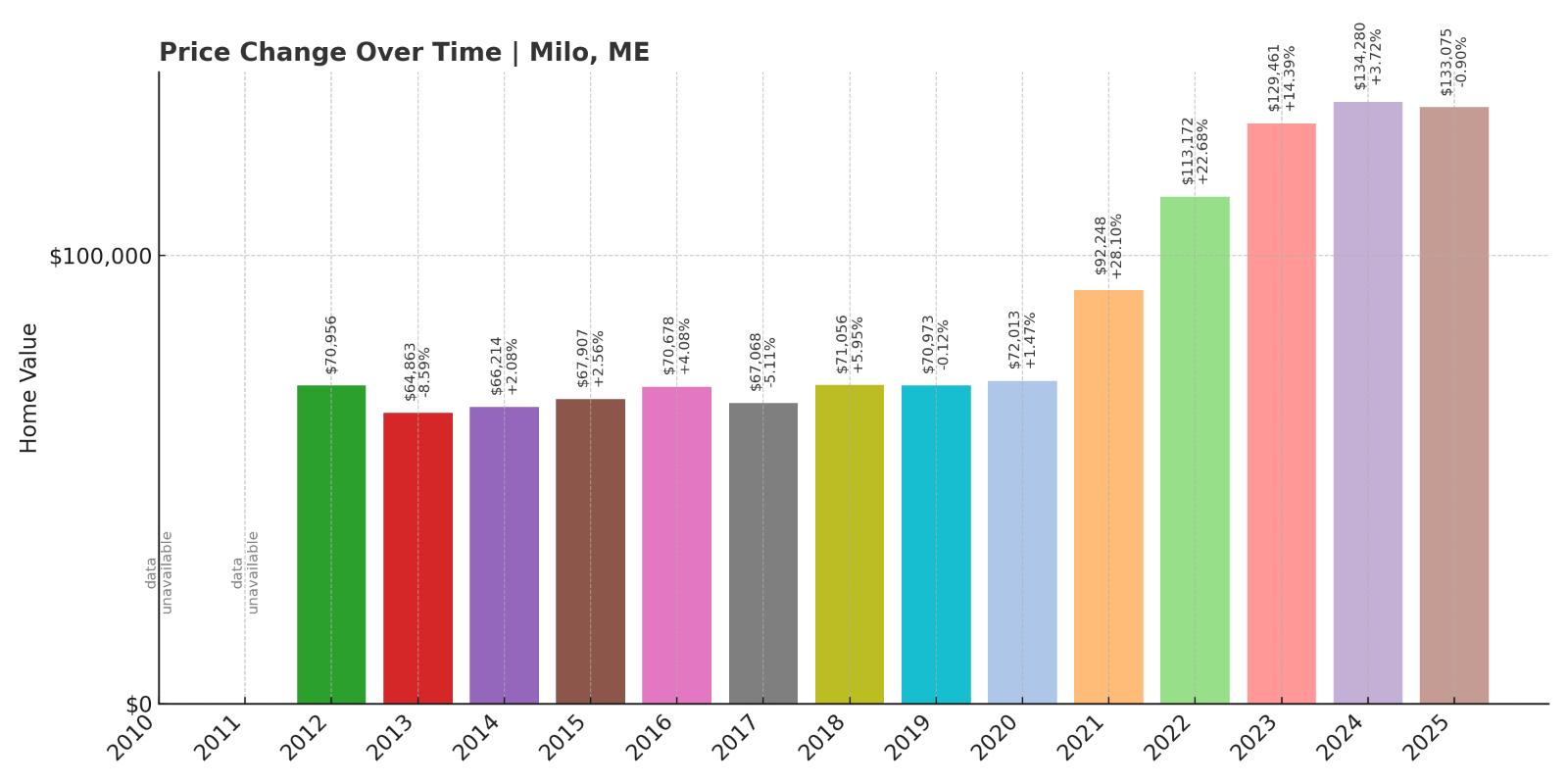
- Crash Risk Percentage: 83.55%
- Historical crashes (8%+ drops): 1
- Worst historical crash: -8.6% (2013)
- Total price increase since 2010: +87.5%
- Overextended above long-term average: +52.2%
- Price volatility (annual swings): 10.0%
- Current 2025 price: $133,075
Milo presents a concerning combination of high volatility at 10.0% annually and significant overextension, with its current median price of $133,075 sitting 52.2% above long-term trends despite representing an 87.5% increase since 2010. This Piscataquis County town experienced an 8.6% crash in 2013, demonstrating vulnerability during a period of relative market stability. The combination of high volatility and proven crash history creates unstable conditions for sustained values.
Milo – Rural Market Instability
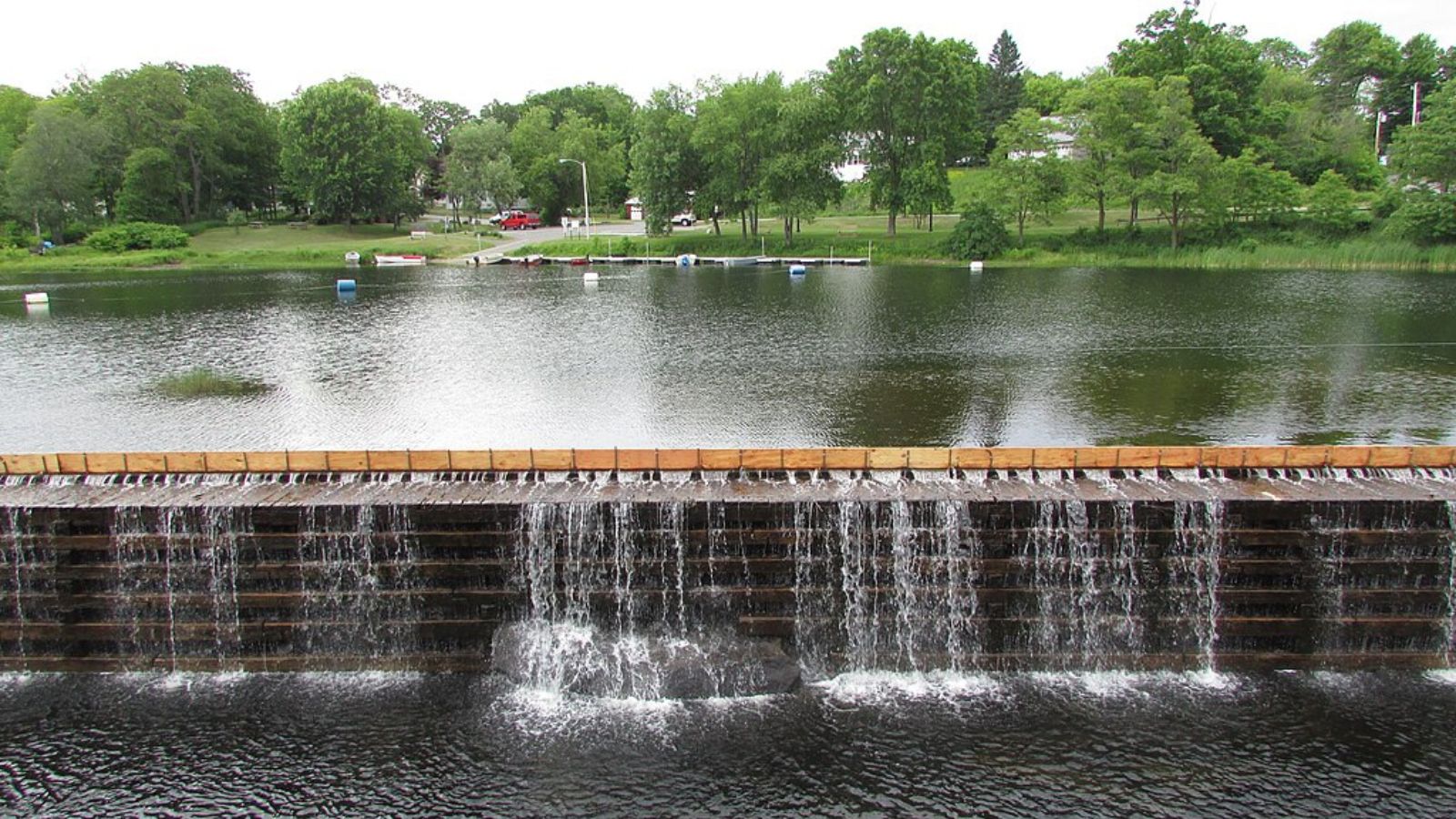
Milo’s 10.0% annual price volatility signals fundamental instability in a rural market that lacks the economic diversity needed to support sustained housing appreciation. The town’s current median home price of $133,075 may appear affordable, but it represents an 87.5% increase since 2010 in an area where economic opportunities remain limited and population continues to decline. This Piscataquis County community’s 8.6% crash in 2013 occurred during a period when most Maine markets remained stable, highlighting particular local vulnerabilities.
The community’s rural location and dependence on traditional industries like forestry and small manufacturing provide limited support for current housing valuations. Milo’s economy has struggled with mill closures and job losses, making the recent housing appreciation appear disconnected from local economic realities. The combination of high price volatility, proven crash vulnerability, and weak economic fundamentals creates conditions where even modest market corrections could result in severe value declines for this rural Maine community.
6. Camden – Crash Risk Percentage: 84.50%
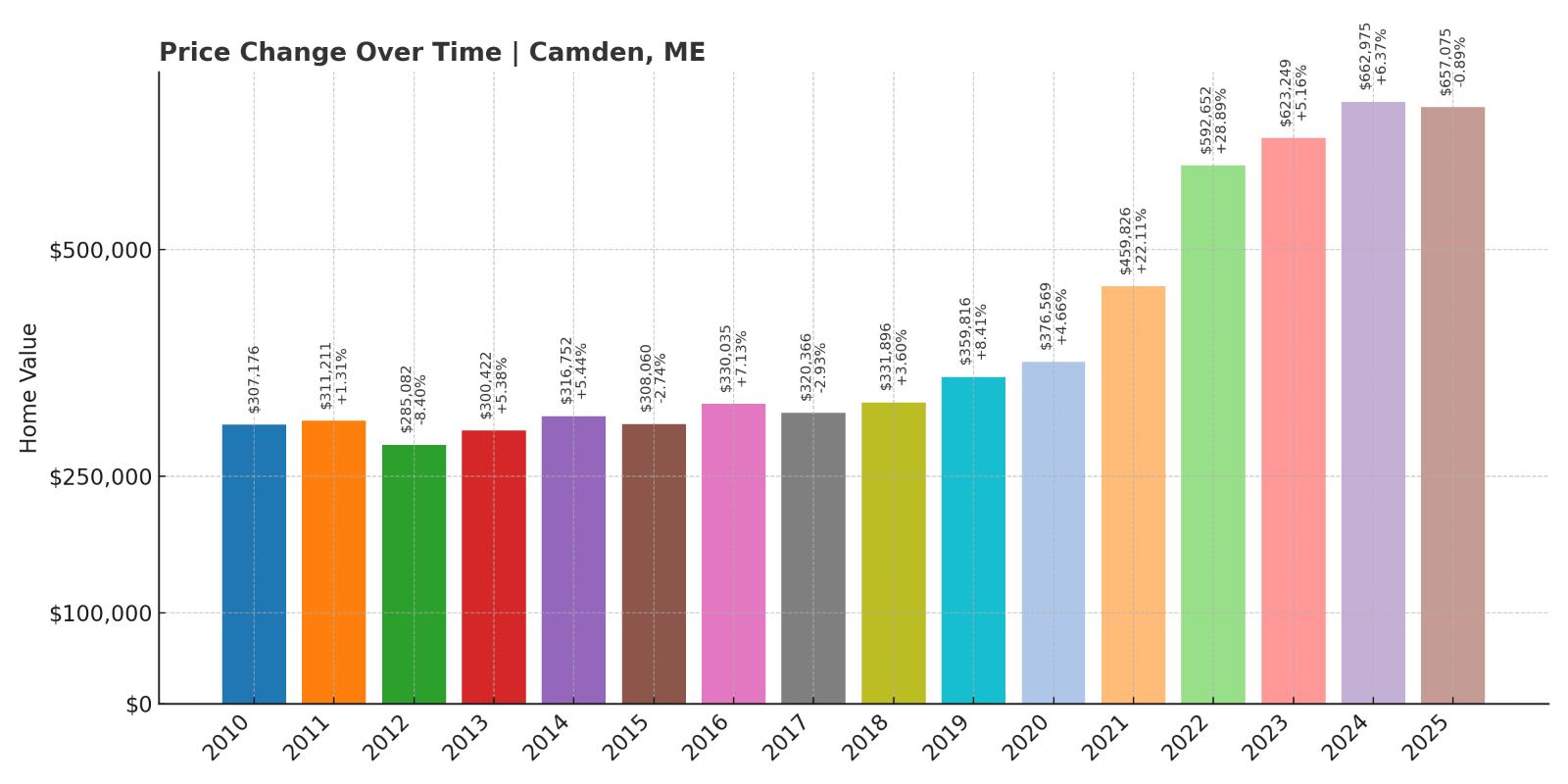
- Crash Risk Percentage: 84.50%
- Historical crashes (8%+ drops): 1
- Worst historical crash: -8.4% (2012)
- Total price increase since 2010: +113.9%
- Overextended above long-term average: +60.7%
- Price volatility (annual swings): 9.1%
- Current 2025 price: $657,075
Camden’s status as one of Maine’s most desirable coastal communities hasn’t protected it from dangerous overvaluation, with its current median price of $657,075 representing a 113.9% increase since 2010 and sitting 60.7% above historical trends. This Knox County town experienced an 8.4% crash in 2012, but current conditions suggest potential for more severe corrections. The community’s high price volatility of 9.1% indicates underlying market instability despite its prestigious reputation.
Camden – Prestigious Market Overextension

Camden’s reputation as one of Maine’s premier coastal destinations has driven dramatic price appreciation, but current valuations have pushed beyond what even affluent buyers can sustainably support. The town’s median home price of $657,075 represents more than double the 2010 levels, creating affordability challenges that threaten the community’s character and economic stability. This Knox County coastal town’s 8.4% crash in 2012 demonstrates that even prestigious markets face vulnerability during broader corrections.
The community’s economy depends heavily on tourism, seasonal residents, and marine-related businesses—all sectors particularly sensitive to economic uncertainty and discretionary spending changes. Camden’s high price volatility of 9.1% suggests underlying market instability that contradicts its image as a stable, high-value coastal market. The combination of extreme overvaluation, tourism dependence, and proven crash vulnerability creates conditions where reputation alone cannot prevent significant value corrections as market dynamics shift across Maine’s coastal communities.
5. Chelsea – Crash Risk Percentage: 85.54%
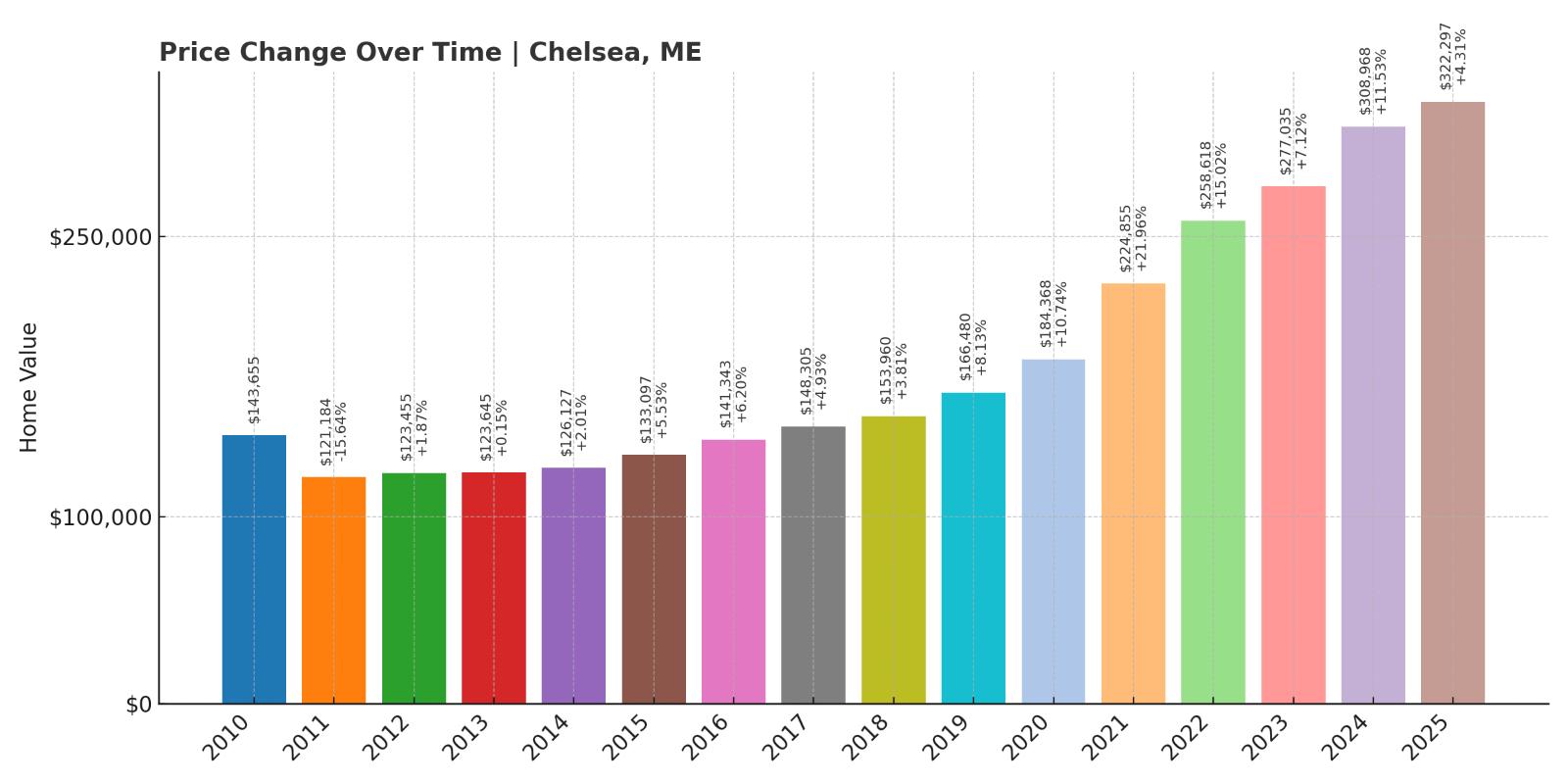
- Crash Risk Percentage: 85.54%
- Historical crashes (8%+ drops): 1
- Worst historical crash: -15.6% (2011)
- Total price increase since 2010: +124.4%
- Overextended above long-term average: +74.4%
- Price volatility (annual swings): 7.9%
- Current 2025 price: $322,297
Chelsea experienced one of the most devastating crashes in our analysis with a 15.6% decline in 2011, yet current conditions suggest even greater vulnerability today. The town’s median home price has reached $322,297, representing a 124.4% increase since 2010 and sitting an alarming 74.4% above long-term trends. This Kennebec County community’s combination of severe historical crash experience and extreme current overextension creates particularly dangerous conditions for homeowners.
Chelsea – Extreme Crash History

Chelsea’s 15.6% crash in 2011 ranks among the most severe housing corrections in Maine during that period, demonstrating the community’s capacity for devastating value swings. The current median home price of $322,297 represents a 124.4% increase since 2010, creating an even more precarious situation than existed before the previous severe crash. This Kennebec County town’s current overextension of 74.4% above long-term trends far exceeds the levels that preceded its previous devastating correction.
The community’s location along the Kennebec River between Augusta and Gardiner has attracted buyers seeking small-town living with urban access, but current valuations appear unsustainable given local economic conditions. Chelsea’s economy provides limited local employment opportunities, making residents heavily dependent on commuting to other areas for work. The combination of proven severe crash vulnerability and current extreme overextension positions the town for potentially catastrophic value declines that could significantly exceed even its harsh 2011 experience.
4. Harpswell – Crash Risk Percentage: 87.72%
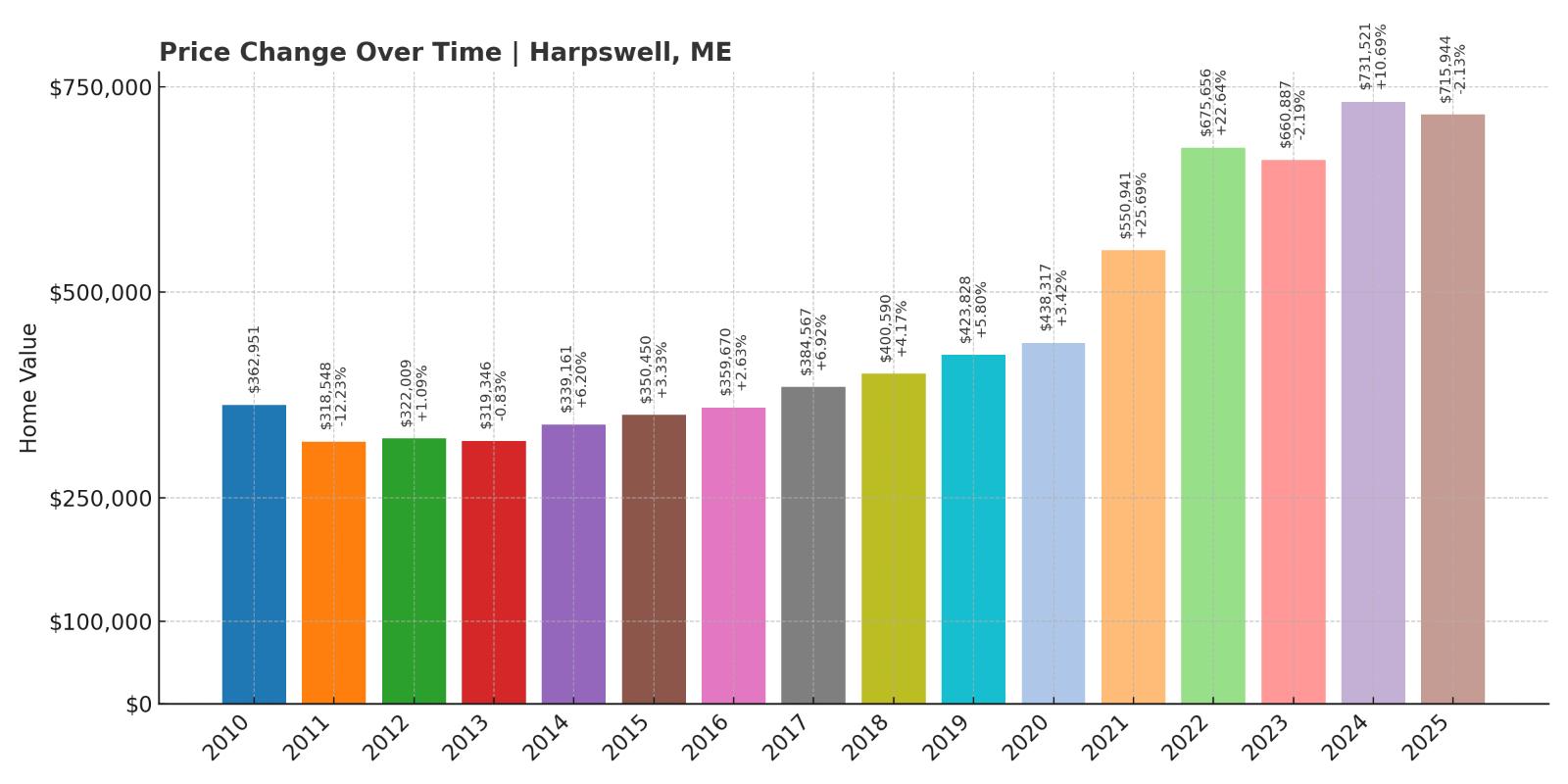
- Crash Risk Percentage: 87.72%
- Historical crashes (8%+ drops): 1
- Worst historical crash: -12.2% (2011)
- Total price increase since 2010: +97.3%
- Overextended above long-term average: +55.8%
- Price volatility (annual swings): 9.1%
- Current 2025 price: $715,944
Harpswell’s coastal location hasn’t protected it from dangerous market conditions, with its current median price of $715,944 representing a 97.3% increase since 2010 and sitting 55.8% above historical trends. This Cumberland County peninsula community experienced a severe 12.2% crash in 2011, demonstrating significant vulnerability to market corrections. The town’s high price volatility of 9.1% indicates underlying instability that creates additional risk for rapid value swings.
Harpswell – Coastal Vulnerability

Harpswell’s 12.2% crash in 2011 was severe for a coastal Maine community, highlighting vulnerabilities that persist despite the area’s natural advantages and tourist appeal. The current median home price of $715,944 represents nearly double the 2010 levels, creating affordability challenges that threaten the community’s working waterfront character. This Cumberland County peninsula’s dependence on marine resources and seasonal tourism makes it particularly vulnerable to economic and environmental pressures.
The community’s authentic coastal character has attracted buyers seeking traditional Maine living, but current valuations appear disconnected from the economic realities of a working waterfront community. Harpswell’s lobstering industry faces ongoing challenges from climate change, regulatory pressures, and market volatility, undermining one of the community’s core economic foundations. The combination of severe crash history, current overvaluation, and economic uncertainty creates conditions where even Maine’s coastal advantage cannot prevent significant value corrections as market dynamics shift.
3. Madison – Crash Risk Percentage: 88.25%
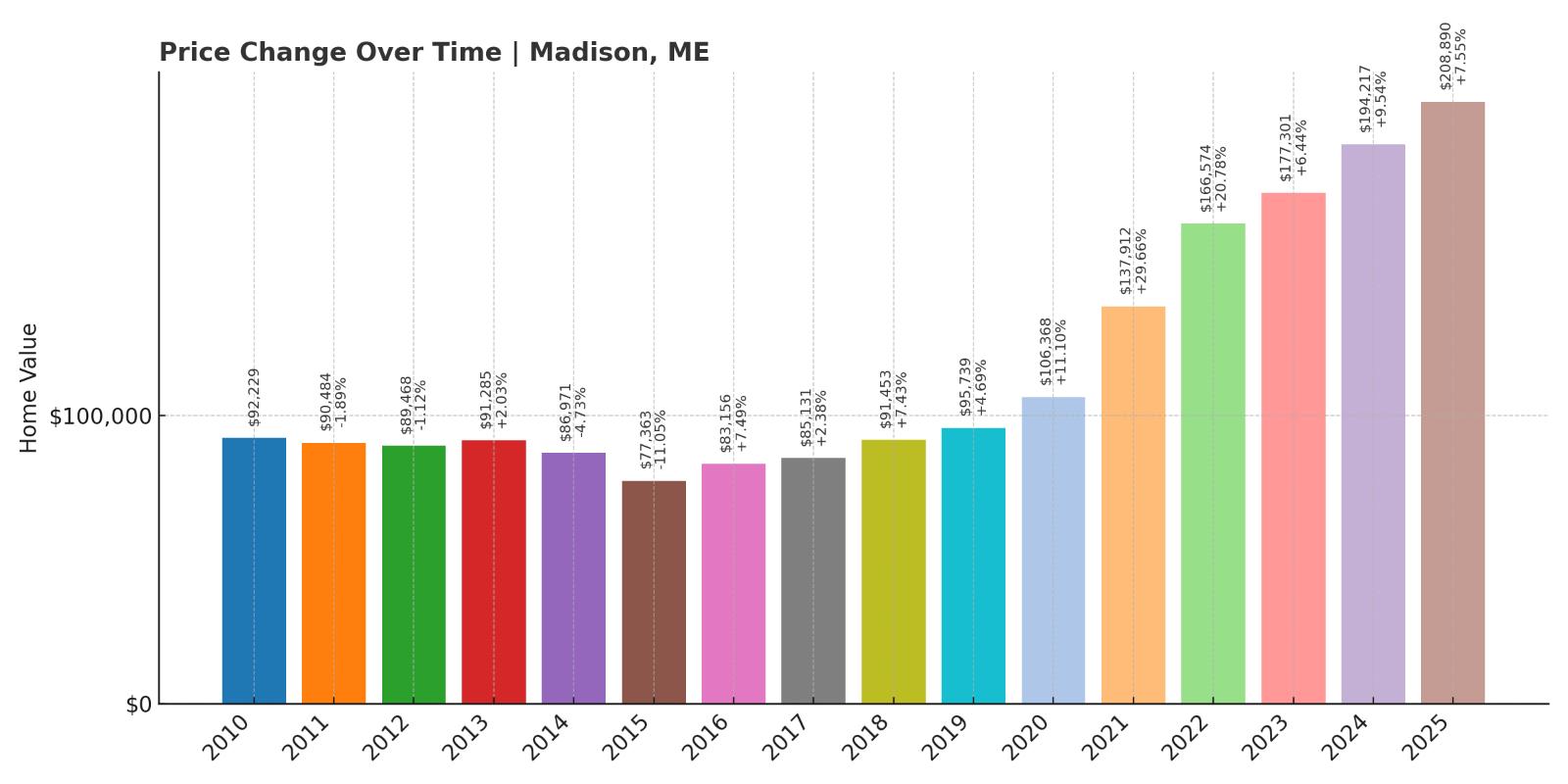
- Crash Risk Percentage: 88.25%
- Historical crashes (8%+ drops): 1
- Worst historical crash: -11.0% (2015)
- Total price increase since 2010: +126.5%
- Overextended above long-term average: +78.3%
- Price volatility (annual swings): 9.6%
- Current 2025 price: $208,890
Madison exhibits some of the most dangerous market conditions in our analysis, with its current median price of $208,890 sitting an alarming 78.3% above long-term trends and representing a 126.5% increase since 2010. This Somerset County town experienced an 11% crash in 2015—more recent than most communities studied—demonstrating ongoing vulnerability. The combination of extreme overextension and recent severe crash history creates particularly unstable conditions.
Madison – Recent Crash Repeat Risk

Madison’s 11% crash in 2015 was both recent and severe, occurring during a period of relative market stability elsewhere in Maine, highlighting fundamental weaknesses in the local housing market that persist today. The current median home price of $208,890 sits 78.3% above long-term trends, representing an even more dangerous overextension than existed before the previous crash. This Somerset County community’s 126.5% appreciation since 2010 has occurred despite ongoing economic challenges and limited local employment opportunities.
The town’s economy has faced significant headwinds from mill closures and industrial job losses, making current housing valuations appear increasingly unsustainable. Madison’s dependence on outside buyers and commuters has driven appreciation, but this demand appears vulnerable to broader economic pressures and transportation cost increases. The combination of recent severe crash history, extreme current overvaluation, and weak economic fundamentals creates conditions where Madison faces exceptional risk of repeating or exceeding its previous devastating correction experience.
2. Damariscotta – Crash Risk Percentage: 88.42%
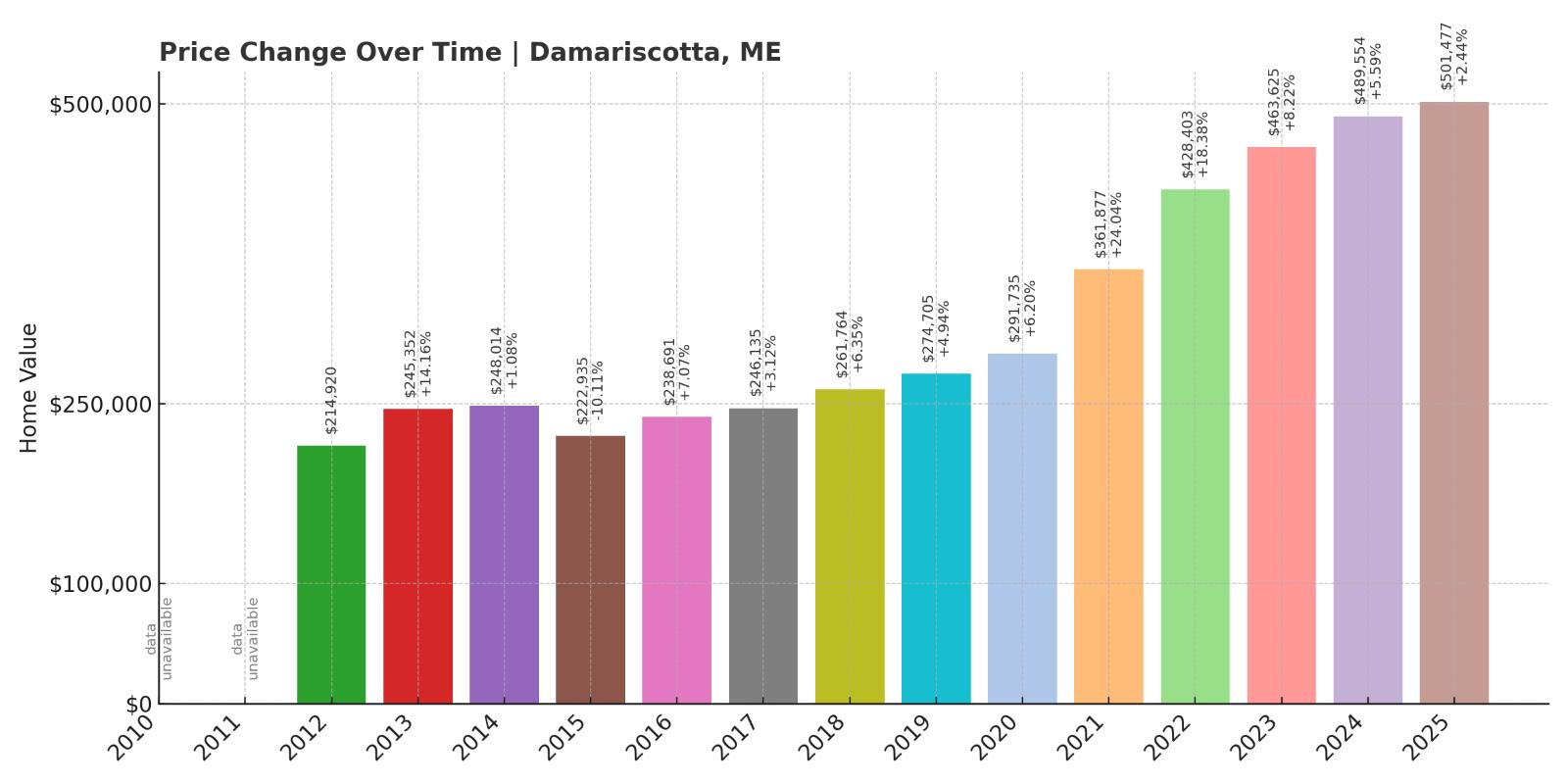
- Crash Risk Percentage: 88.42%
- Historical crashes (8%+ drops): 1
- Worst historical crash: -10.1% (2015)
- Total price increase since 2010: +133.3%
- Overextended above long-term average: +56.4%
- Price volatility (annual swings): 8.1%
- Current 2025 price: $501,477
Damariscotta shows extreme appreciation with its median price reaching $501,477—a staggering 133.3% increase since 2010 that ranks among the highest in our analysis. This Lincoln County town experienced a significant 10.1% crash in 2015, and current overvaluation levels sitting 56.4% above long-term trends suggest potential for more severe corrections. The combination of extreme appreciation and recent crash history creates particularly dangerous market conditions.
Damariscotta – Extreme Appreciation Bubble

Damariscotta’s 133.3% price appreciation since 2010 represents one of the most extreme examples of housing market inflation in Maine, creating mathematical unsustainability that cannot be maintained given local economic conditions. The current median home price of $501,477 has pushed far beyond what residents in local retail, healthcare, and service jobs can afford, threatening the community’s economic diversity. This Lincoln County town’s 10.1% crash in 2015 demonstrates that even regional service centers face vulnerability to severe corrections.
The community’s role as a Lincoln County service hub and its coastal location have driven demand, but current valuations appear disconnected from the economic fundamentals of a small Maine town. Damariscotta’s economy relies heavily on local businesses, seasonal tourism, and regional services—sectors that cannot support the extreme price levels reached over the past decade. The combination of record-level appreciation, proven crash vulnerability, and current overextension creates conditions where this popular mid-coast community faces exceptional risk of severe value corrections.
1. Freeport – Crash Risk Percentage: 95.00%
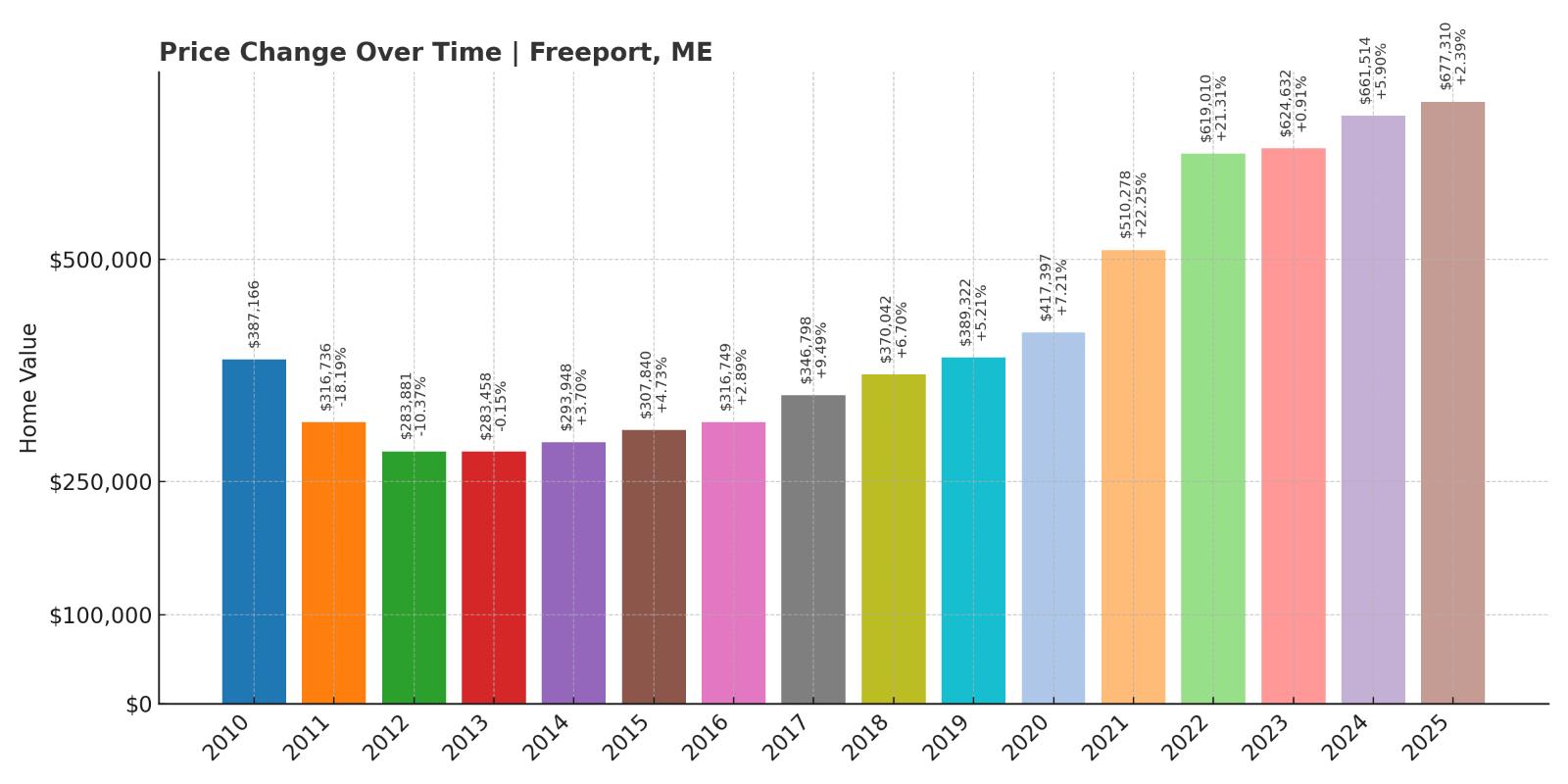
- Crash Risk Percentage: 95.00%
- Historical crashes (8%+ drops): 2
- Worst historical crash: -18.2% (2011)
- Total price increase since 2010: +74.9%
- Overextended above long-term average: +59.2%
- Price volatility (annual swings): 9.7%
- Current 2025 price: $677,310
Freeport tops our crash risk analysis with a devastating 95% vulnerability score, driven by its status as one of only two communities with multiple historical crashes and the worst single crash in our study at 18.2% in 2011. The town’s current median price of $677,310 represents a 74.9% increase since 2010 and sits 59.2% above long-term trends. This Cumberland County community’s combination of severe crash history, current overvaluation, and high volatility creates the most dangerous conditions in our analysis.
Freeport – Maximum Crash Risk

Freeport’s 18.2% crash in 2011 stands as the most severe housing correction in our analysis, demonstrating the community’s capacity for devastating value swings that exceed typical market corrections. The town’s status as one of only two communities with multiple historical crashes reveals fundamental market instability that persists despite its famous retail attractions and tourist appeal. The current median home price of $677,310 sits 59.2% above long-term trends, creating dangerous overvaluation conditions similar to those that preceded previous crashes.
The community’s dependence on L.L.Bean, outlet shopping, and tourism creates economic vulnerability that translates directly into housing market instability. Freeport’s high price volatility of 9.7% signals ongoing market uncertainty, while its pattern of multiple crashes suggests that severe corrections are not isolated events but recurring features of the local housing market. The combination of the worst historical crash in our study, multiple crash experiences, current overvaluation, and high volatility creates maximum risk conditions where homeowners face exceptional vulnerability to severe value losses that could exceed even the town’s devastating previous correction experiences.
